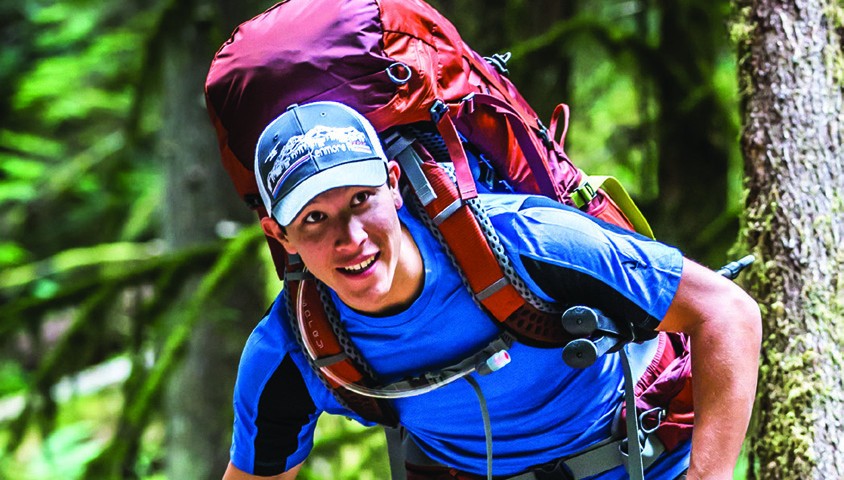Osprey Atmos 65 (1.98kg, 65L) – $299.95
In the mountains, with a chill wind biting in from the southwest, it would be nice if there were someone there to give you a cuddle. The first time I put on Osprey’s Atmos 65, it felt as though I was being embraced by a long, lost relative. Perhaps we’ve had past life-hikes together, but there was something instantly familiar about the way the hip straps hugged my waist. The more I wore this pack, the more I realised it wasn’t familiarity, more so the way this incredibly comfortable pack is designed. The one-size-fits-all adjustable hip strap means that you can be as lax between hikes as you want; it doesn’t matter if you’ve gone too hard on the pies and booze because the Atmos will take you into its arms – flabby guts and all – and adjust to wherever you’re at. There’s a generous length of waist strap that moulds to the contours of your gut. Any excess slides inconspicuously back into the hip strap. Having this feature adds a bit more weight to this 1.98 kilogram pack, but it’s a small price to pay for such flexibility.
The pack stuck to me like a newborn cub despite my hip shaking, sidestepping manoeuvres.
And it’s all about flexibility; the Atmos is a veritable yogi of the backpacking fraternity. It has an adjustable and nifty anti-gravity suspension system, which doesn’t mean you can fly over ravines, rather its curved, mesh-covered back panel not only provides airflow, but it also contours to the shape of your torso. I’ve never had a pack where the load doesn’t rest on my back before, so I was interested to see if shifting the weight away from my body would compromise my ability to balance while out bush, ducking around trees, boulder hopping and scrambling. The pack stuck to me like a newborn cub despite my hip shaking, sidestepping manoeuvres. This is down to getting the pack properly fitted and the adjustable harness system that enables specific torso tailoring and a snug fit.
The specs say that the Atmos 65 is designed to carry a load of roughly 13.5 kilograms to 22 kilogram. I found the optimum load for remaining agile was between 15 and 16 kilograms (this may differ from person to person, depending on body size). This top-loading pack has reasonable volume. My tent is a bulky three kilograms that doesn’t pack down super small, but after I stuffed it to the bottom there was still ample room for everything else. Those struggling for room inside the main compartment can attach their mattress to removable sleeping pad straps located externally near the base of the pack.
One of my favourite features is a detachable top lid. This is ideal if you want to leave the pack on the trail, stuff your lunch inside it and go sit on a summit for a bite to eat. Other features of this pack include dual vertical front zippered pockets that are good places to stash a raincoat or map, or your lunch for ease of access. There is a ‘Stow-on-the-Go’ trekking pole attachment system, which is pretty self-explanatory. Once the poles are stashed however, accessing them without taking off the pack can be tricky. If you’re heading to the snow, then there are also places to hang an ice axe. There’s a waffle-foam harness (sadly without strawberries and cream) and dual hip-belt pockets, which are perfect places to store a compass and small snacks.
This is a pack with whistles and bells. OK, there are no bells but the sternum strap has a built-in whistle for attracting attention.
This is a pack with whistles and bells. OK, there are no bells but the sternum strap has a built-in whistle for attracting attention. There’s a hole at the top back part of the backpack through which you can feed a bladder hose. The pocket for the bladder itself resides inside the backpack, but this may be awkward to use if your pack is chock-a-block full, in which case you’ll just have to plonk the bladder on top of your gear. The front mesh pocket can also be cumbersome if the pack is fully loaded as there isn’t an amazing amount of give, which limits what you can put in there. Elastic side-pockets can be found at the bottom of the pack on each side, but these aren’t really that useful because things can easily fall out.
The main body of the Atmos is made with 100D x 630D nylon dobby main fabric. This is supposed to be pretty water resistant, and it wants to be because the pack doesn’t come with a rain cover.
I’ve been using a 90-litre backpack for many years and while it’s performed well, having something so big means I’m lugging 25 kilograms on multi-day trips and that the top of the bag gets snagged on branches a lot. The Atmos 65 is a good transition into more lightweight, nimble trekking and offers more dexterity in the bush.



